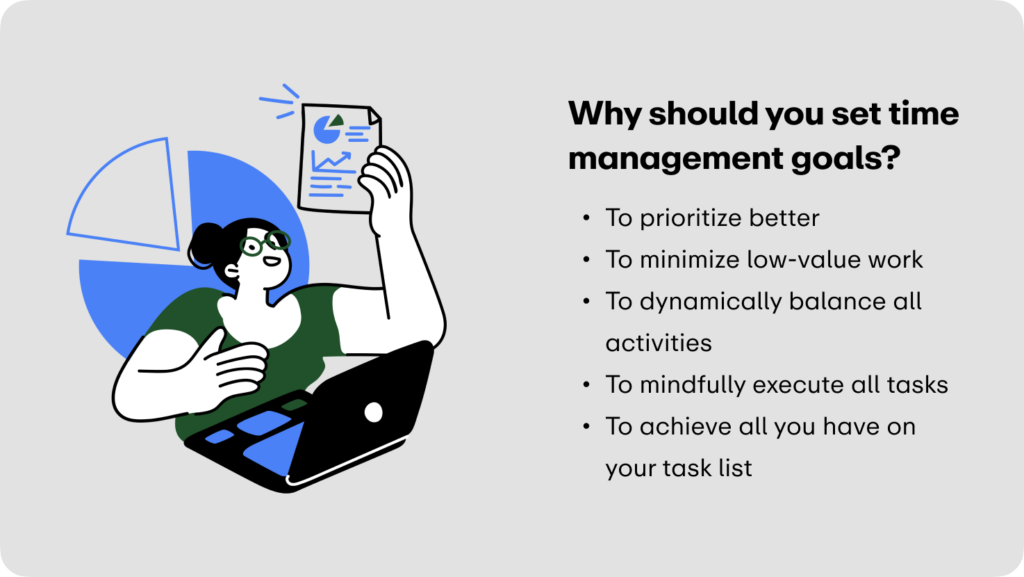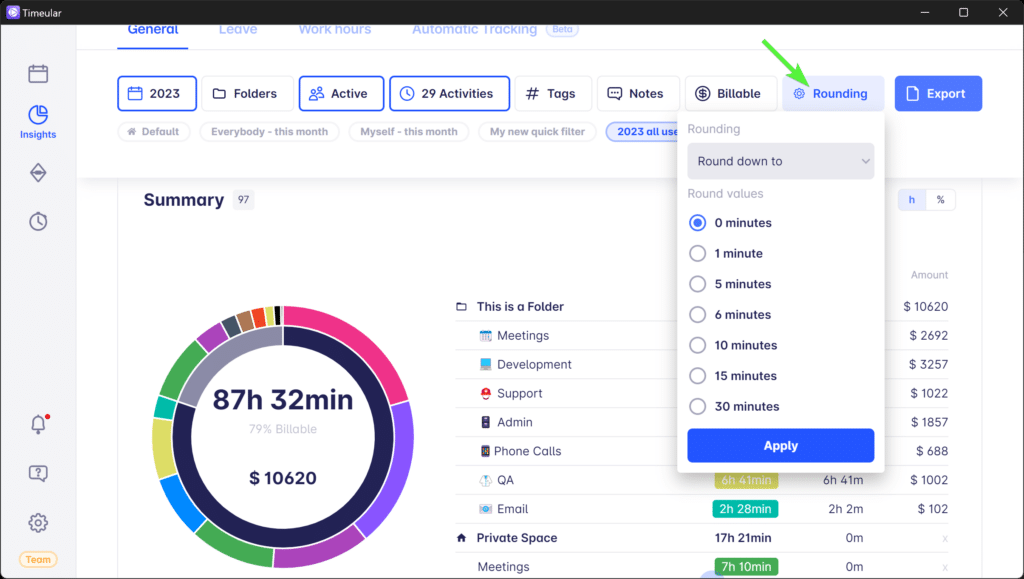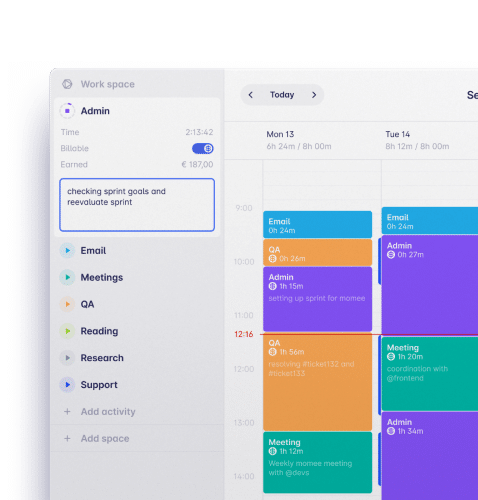Time Management Goals to Maximize Your Productivity
You likely have goals for every area of your life. So, you’re wondering: is time also an area where you should have goals?
Well, considering that time determines the achievement of all the other objectives, it’s worth investing energy and effort into managing it.
Dive into this article to learn how to set your time management goals and each step that contributes to achieving them.

What are time management goals?
Time management goals are strategic objectives that aim to optimize the use of your time. Even if time is an intangible asset, consider that goal-setting contributes to obtaining a yield of your investment in time. The best output in setting goals for time management is that it allows you to be intentional about your time while achieving productivity.
What’s more, these goals challenge you to align your time investment with your deepest values, aspirations, and long-term vision.
Why do you need time management goals?
Besides allowing you to align the way you spend your time with your short and long-term goals and broader vision, proper time management goals empower you to do the following:
- Prioritize purposefully: Focus your time and energy on high-impact work that drives meaningful progress, fulfills work that matters, and fills your cup.
- Minimize low-value busy work: Achieving success, whether it is in your professional or personal life, is rarely about focusing on low-value activities. It is about high-priority tasks that need to be managed accordingly.
- Balance all activities dynamically: Allocate time flexibly across all your life areas, including work, family, health, learning, and leisure, and adapt as circumstances change. This way, you can achieve the highly sought-after healthy work-life balance and stay away from burnout.
- Execute mindfully: Engage fully in the present moment, focusing fully on each activity. When you have control over your schedule, time anxiety disappears and allows you to work deeply without distraction on cognitively demanding tasks.
- Reflect and optimize time spending: With time management goals set, you’re able to pause periodically to review time usage, celebrate progress, and realign priorities. That’s possible due to having a smart goal against which you can measure your time management skills and behaviors. Otherwise, without time management goals, you’re unaware of how you spend time, what your time wasters are, and how to optimize it.

Ultimately, time management goals enable you to live and work more intentionally, focus on what matters most to you, and achieve personal and professional success.
🎯 On the same topic, you can check our comprehensive guide on writing work goals, too. It’s packed with advice on how to set your career goals to shy these matters of work goals from our team, and not only.
How to set time management goals
1. Start by thinking what your relationship with time is
You need to first reflect and admit the truth about how you’re spending your time. If you have a time audit full of “red flags,” then you know it’s high time you set time management goals for yourself.
Ask yourself the questions like:
- Do I often lose control of my time and get frustrated?
- Am I always missing deadlines?
- Am I often anxious about not finishing my to-do list?
- Am I taking on too much and spreading myself too thin?
- Do I understand how I spend time on daily tasks?
- Do I have any effective time management strategies to resort to when I lose control of my time?
If your list has 3 or 4 answers of “yes,” then you know you need to get cracking, as you have poor time management. If your list is not that red-flagged, there’s always an improvement you can make to your time management skills.
🎯 On the same topic, check our time management skills guide to learn about reasonable goal setting, energy management, and others.
2. Start identifying areas to improve
Pinpoint the exact areas where your time management needs work.
This could be prioritizing tasks or spending focused time when you struggle with attention. Other areas can be delegating tasks or saying no to work, as you’re always overwhelmed with too much work.
3. Define your time management goals
More often than not, we have a problem defining time-bound goals around any area of our lives, let alone goals directly related to time management. Therefore, you need to craft your smart goals (smart time management goals, aka specific, measurable, achievable, relevant goals). Here are some goals that are built based on the SMART framework criteria:
- “I will prioritize my top 3 crucial tasks on a daily basis and complete them before dealing with anything else.”
- “I will change my email checking behavior to only 3 times a day.”
- “I will dedicate family time every evening from 6 pm to 8 pm and remove all other tasks.”
4. Develop an action plan
Break your goals down into concrete steps and habits you can implement. Also, it’s beneficial to assign deadlines to keep yourself accountable. For instance:
- “I will start each morning by listing my top 3 important tasks.”
- “I will use a Pomodoro timer to work in focused 25-minute blocks with 5-minute breaks in between.”
- “I will set ‘Do Not Disturb’ on my phone during family time.”
5. Review and adjust regularly
Assess your progress weekly or monthly based on how your relationship with time evolves. A time audit with time-tracking software is the easiest way to review if your time management skills are better, as it surfaces all time-related matters in a report like this one:

Other simpler ways are to check and understand if you have a better work-life balance and if you now have more control of your time with different time management techniques. Celebrate your success, learn from setbacks, and tweak your goals.
Time management goals [examples]
Now that you have a framework on how to set your time management goals, here are five goal examples with specific implementation strategies:
1. Identify your time-wasting activities
Time management is more than just a skill. It starts with understanding your time spent on tasks and time wasted on low-impact work so you can start making steady progress toward what matters most.
- What you need to do: Use time-tracking software (EARLY) to track all work-related activities for the next 30 days. Your aim will be to log at least 95% of tasks and analyze weekly reports to identify your time-wasters.
- Purpose: Gain insights into your time usage, schedule tasks more realistically based on your time-consuming behaviors, and eliminate inefficiencies.

Powered by AI and supercharged with easy-to-use methods, EARLY helps you track your time and manage it in < 1 minute a day.
Steps:
- Set up categories and tags in EARLY that are aligned with work priorities (e.g., calls, writing, emails).
- Commit to using the app consistently during work hours. The great thing about EARLY is that it automatically tracks your work without any manual action once you set it up.
- Schedule a 15-minute review every Friday to track progress, analyze the weekly report, and adjust priorities for the following week.
- Set time management goals based on your observations (e.g., reduce meeting time by 10% by the end of the month).
Tip: The image shows a time report in EARLY, which surfaces data like productive and unproductive app usage, times when you are the most productive, and others.

2. Prioritize tasks effectively
Completing tasks is hard if all you do is put out fires in a day. So you need to learn to prioritize tasks, and I don’t refer only to the urgent tasks but also to all the activities that pushed you forward on many projects.
- What you need to do: Use a prioritization strategy called the time management matrix (aka the Eisenhower Matrix) each day. This way, you understand which tasks are high-priority and must be tackled first.
- Purpose: By prioritizing effectively, you will make sure that your most critical work gets done on time, manage stress from looming deadlines, and progress with work.
Steps:
- Create a daily to-do list: List all your tasks at the beginning of your day.
- Assign your tasks into quadrants:
- Urgent and important (Do Now).
- Important but not urgent (Plan).
- Urgent but not important (Delegate).
- Neither urgent nor important (Eliminate).
- Schedule focus time: Dedicate your most productive hours to tasks in Quadrant 1 and Quadrant 2.
- Review regularly: At the end of each day or week, reassess your matrix to see if this time management technique works for you or if you need to adjust it, and maybe try another strategy.
🎯 On the same topic, you can familiarize yourself with time management strategies like making knockout lists, grouping your interruptions, and leveraging time management tools.

3. Reduce procrastination
Procrastination wrecks productivity, but we’re all guilty of it, maybe more than we’d like to recognize. The problem is that procrastination holds you back from achieving your goals and causes unnecessary stress.
If there’s an activity that you’re procrastinating most on, it is likely the hardest or unattractive task on your list.
- What you need to do: Use the Eat the Frog technique each morning of your work week. The “frog,” in this case, is the challenging task mentioned above. You basically need to start and complete this task first thing in the morning so you don’t drag it endlessly with you.
- Purpose: Tackle high-value work when your energy is at its peak, reduce mental clutter, and create a sense of accomplishment early in the day. And, of course, reduce procrastination.
Steps:
- Identify your frog: Each evening, identify the most crucial task you need to complete the next day, and you dread it.
- Prioritize it: Make your frog the first thing you address in the morning before any distractions or smaller tasks.
- Break it down: If the task feels overwhelming, break it into smaller, actionable steps to make starting easier and easier to stay focused on it.
- Commit to focus: Set a timer for focused work (e.g., 60–90 minutes) and make sure your task gets your full focus.
- Reward yourself: Once your frog is “eaten,” reward yourself with a break or a small treat to reinforce this new habit.
4. Implement time blocking
If you’re struggling with managing distractions and staying focused only on one task at a time, time-blocking techniques will help you spend your time effectively.
- What you need to do: Use one time-blocking technique to divide your day into dedicated periods for specific activities. For this example, I’ll use the widely known Pomodoro technique.
- Purpose: Time blocking generally helps eliminate distractions, reduce decision fatigue, and finally reach those desired outcomes.
Steps:
- Choose a task: Select a specific task to focus on during your Pomodoro session (it can be any type of task, from difficult to routine tasks).
- Set a timer: Start a timer for 25 minutes and commit to working on the task without interruptions.
- Take a short break: Once the timer goes off, take a 5-minute and recharge. Grab a coffee or tea or stretch a bit.
- Repeat the cycle: After four Pomodoros, reward yourself with a longer break of 15–30 minutes.
- Track your sessions: Use a notebook or a free digital Pomodoro timer to track completed Pomodoros and measure your productivity over time.
5. Reduce task switching by 50%
Constant task switching kills your productivity and depletes your mental energy, yet many of us jump between tasks dozens of times daily. Each switch requires your brain to refocus and consume much more mental energy than if you stayed focused only on one task.
- What you need to do: Implement a “batching system” where you group all similar tasks together and complete them in dedicated time periods. For the next 10 days, track your task switches with a productivity tracker so you can have a baseline and then monitor your progress.
- Purpose: When you’re reducing context switching, you’re decreasing mental fatigue, and as research suggests, you can become 40% more productive.
Steps:
- Create task categories: Group all similar tasks together (e.g., emails, phone calls, creative work, administrative tasks).
- Schedule batch sessions: Set specific time blocks in your calendar for each category of tasks (e.g., email reading from 9-9.20 AM and 4-4.30 PM).
- Implement a “completion before switching” rule: Finish one batch entirely before moving to another unless there’s a real emergency.
- Set up your environment: Close unnecessary tabs, turn off notifications and use website blockers during focused batch sessions. Otherwise, there’s a high chance your focus will be diverted.
- Track progress: Log your task switches daily and calculate your weekly average to make sure you hit your 50% target.
Choose your goals and go for it
Now, you have a structured framework to start improving your relationship with time. Whether you are looking for better mental health, you want to stay organized, achieve goals with ease, and have an overall harmonious work-life balance, time is the currency that leads to all these objectives.
So, choose your time management goals and let time work for you and your objectives.
